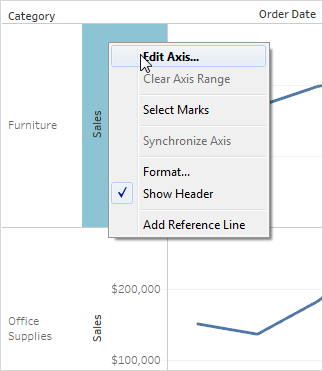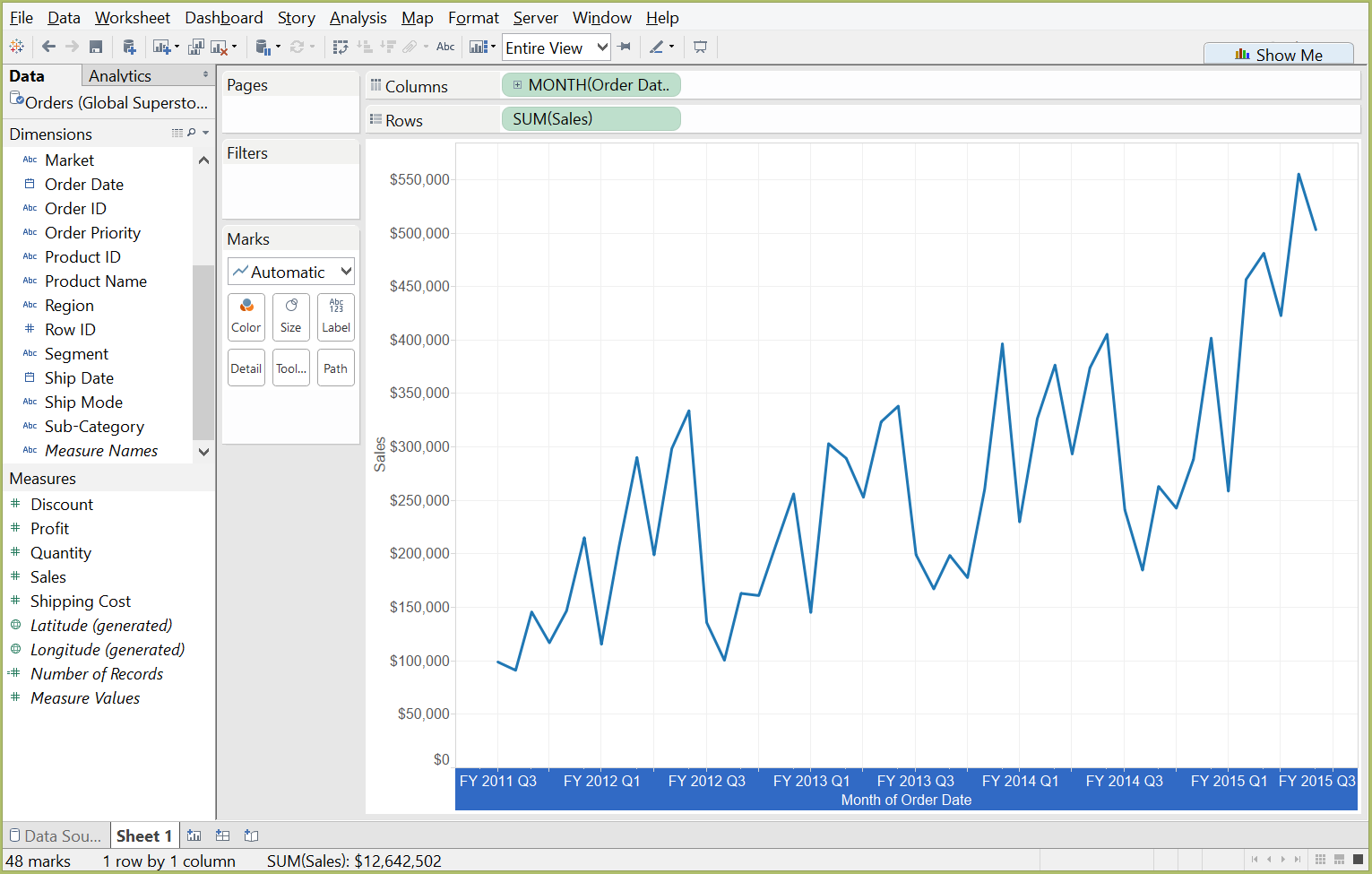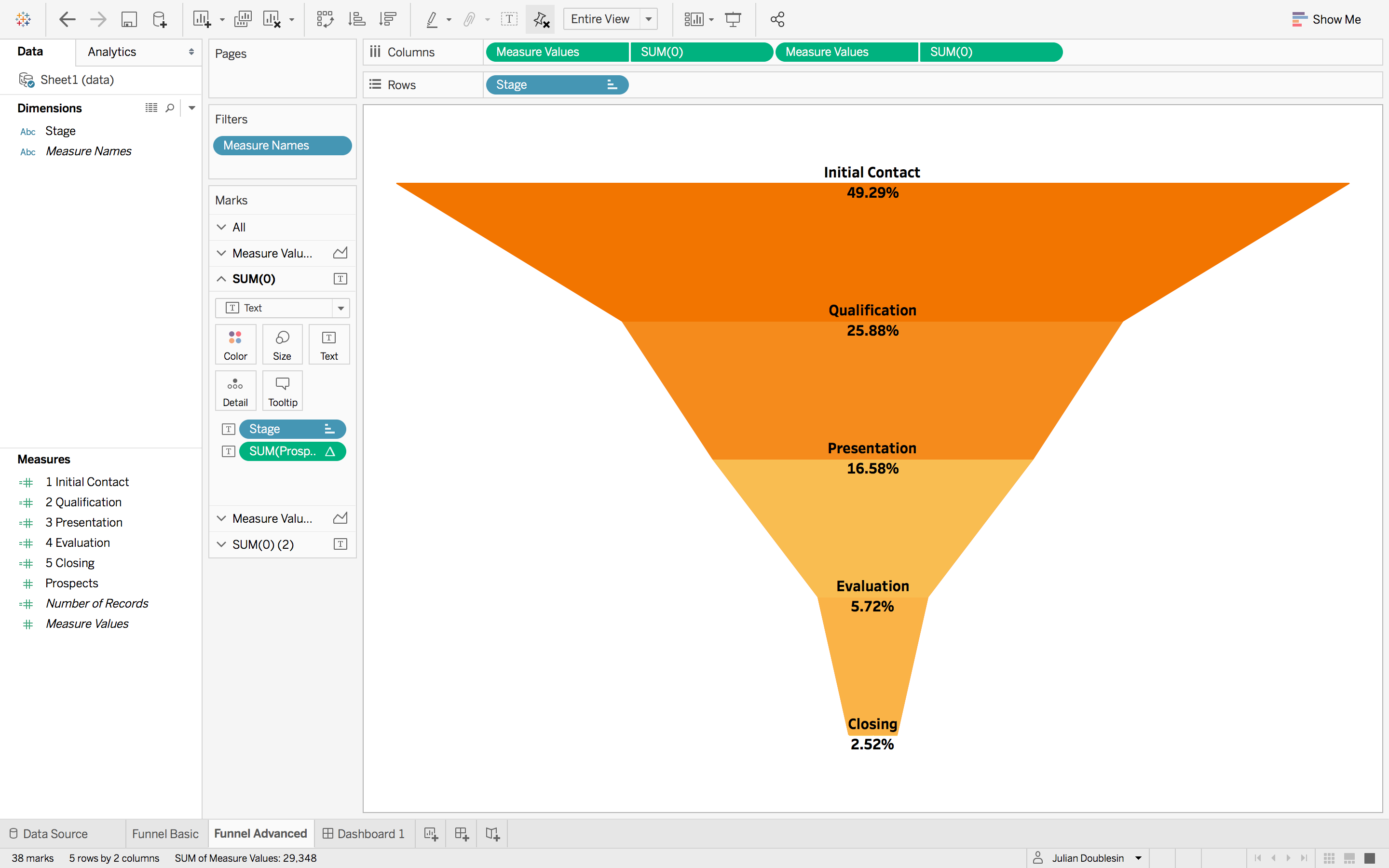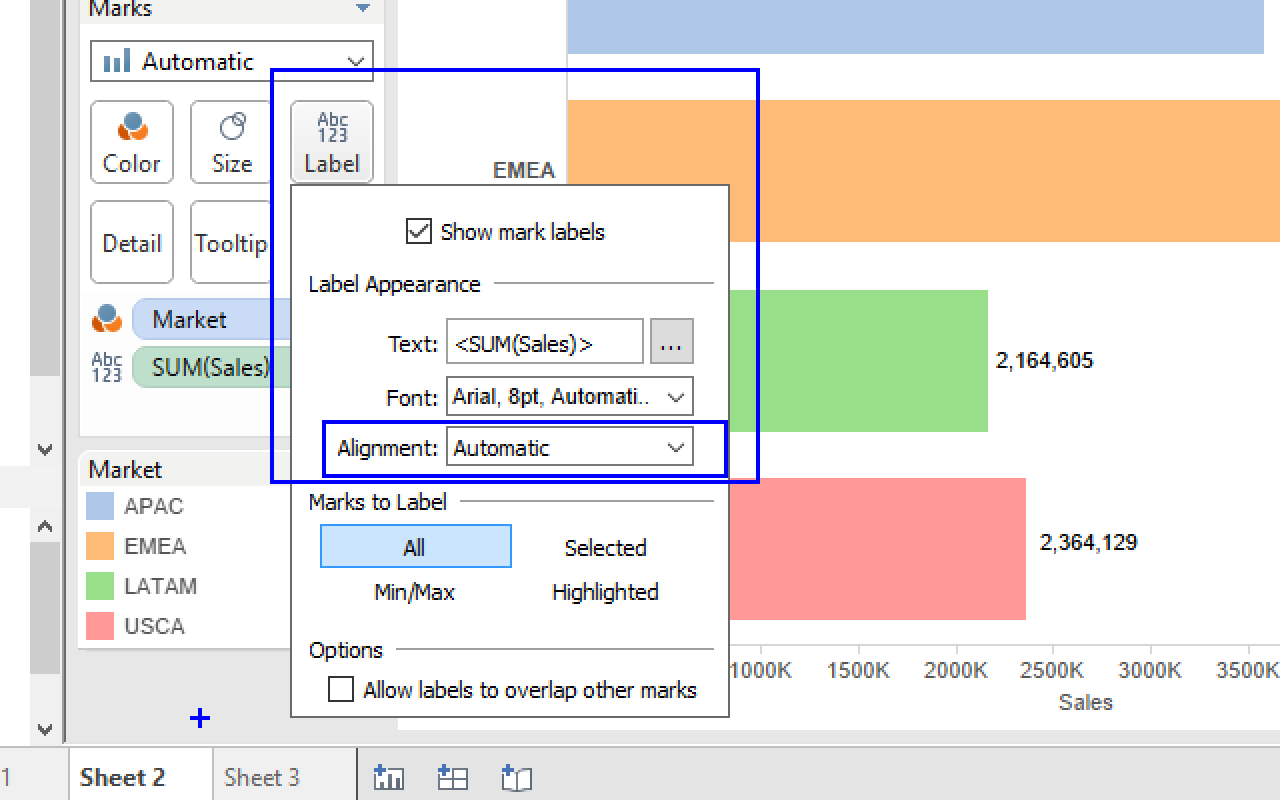43 tableau custom axis labels
Creating Conditional Labels | Tableau Software Tableau Desktop Answer Option 1 - Based on field values Using calculated fields, you can create conditional data labels based on a custom field that includes only the values of interest. This step shows how to create a conditional label that appears on a mark only when a region's sales for a day are greater than $60,000. Take Control of Your Chart Labels in Tableau - InterWorks But this is a separate topic, so feel free to skip to the Show Only the First N Labels section. To highlight the last five labels, drag and drop a copy of the newly calculated field to Rows to the right of SUM(Revenue). Right-click on it and select Dual Axis. Right-click on any of the axes and select Synchronize Axis.
Tableau Essentials: Formatting Tips - Custom Shapes - InterWorks You'll get the Edit Shape dialogue box. Click on the Select Shape Palette drop-down menu to find My Custom Shapes. This is where we stored all of our shapes in the My Tableau Repository folder in My Documents. You should see all of your custom images in the box below the drop-down. Now, simply select your data item and click on the image you ...

Tableau custom axis labels
Tableau Tip: Conditional Axis Formatting Using an Axis Selector - VizWiz Step 2 - Create a map for each metric. Again, I end up with one worksheet for each metric. Step 3 - Create a bar chart for each metric, giving us three more worksheets for a total of nine. Step 4 - Create a parameter with a list of the metrics. Step 5 - Create a calculated field to get the value selected in the parameter created in Step 4. How to Apply Dual Axis in Tableau? - EDUCBA Step 1: First load the requisite dataset into Tableau. For this click on the Data menu, and under it, click on the "New Data Source" option. Alternatively, one can also load the data source by clicking on "Connect to Data". Step 2: Select the requisite data source type. In this case, it is Microsoft Excel. Change axis labels in a chart - support.microsoft.com On the Character Spacing tab, choose the spacing options you want. To change the format of numbers on the value axis: Right-click the value axis labels you want to format. Click Format Axis. In the Format Axis pane, click Number. Tip: If you don't see the Number section in the pane, make sure you've selected a value axis (it's usually the ...
Tableau custom axis labels. Custom Shapes as Axis Labels | Tableau Software Right click SUM (Custom Shapes) and change the measure to MIN. Right click the "Custom Shapes" axis and select edit axis. Select the fixed range. Set the range the start to .9 and the end to 1.1. Click ok. Then, right click the x axis and uncheck show header. In the marks card, "Min (Custom Shapes)," select shape from the drop down menu. How to Dynamically Change Axis Measures and Formats in Tableau Using ... Step One: Create Sheets for Each Metric First, create two separate sheets for each metric you want to display. You can duplicate functionality from one sheet and then format each y-axis appropriately. For the Sales chart, we format as currency, and for Profit Ratio, we format as a percentage. Sales Sheet Profit Ratio Sheet Add Axes for Multiple Measures in Views - Tableau Blend two measures to share an axis. Add dual axes where there are two independent axes layered in the same pane. In any of these cases you can customize the marks for each axis to use multiple mark types and add different levels of detail. Views that have customized marks are called combination or combo charts. Tableau Confessions: You Can Move Labels? Wow! Wow! Tableau Confessions: You Can Move Labels? Wow! Andy Cotgreave. Technical Evangelist Director, Tableau. January 28, 2016. I was on a call with Zen Masters Steve Wexler, Jeff Shaffer, and Robert Rouse. We were talking about formatting labels, and Robert was saying, "Well, of course, you can just drag the labels around.". "Wait.
Custom Axes in Tableau - VIZJOCKEY.com | co-data.de Custom Axes in Tableau. Mar 4, 2022 . Klaus Schulte. In this blog I'd like to share one of the coolest things I've ever created in Tableau. ... For the tick labels, we start with Tick_min and add further steps as long as the (Object ID-1) is less or equal than the number of steps needed. Updating Dynamic Axis Titles Automatically | Tableau Software Right-click on the axis in the visualization and select Edit Axis.... Delete any text in the Title box in the bottom right, and click OK. Repeat steps 1 and 2 for the second axis. Adding the Calculated Fields to the Visualization Drag each calculated field f to their respective row shelf or column shelf. How to use custom shapes as axis labels in Tableau Click on the Dimensions ("Items") pill on the Rows shelf and from the menu select 'Show Headers' to remove the traditional axis labels from the view. Only the icons should remain next to the bars. 9. Clean up the remainder of the chart by right-clicking on each x-axis and selecting 'Show Header' to remove the axis from the view. Format Fields and Field Labels - Tableau Right-click (control-click on Mac) the field label in the view and select Format. In the Format pane, specify the settings of the font, shading, and alignment field labels. Note: When you have multiple dimensions on the rows or columns shelves, the field labels appear adjacent to each other in the table.
Ten Tableau Text Tips in Ten Minutes - Playfair Data 1 - How to install custom fonts in Tableau. ... 7 - How to make vertical axis labels in Tableau. My friends over at Workout Wednesday recently had a weekly Tableau challenge that included rotating the labels of a y-axis on a Tableau chart. By default, axis labels are vertical and must be read from bottom to top as you can see with the word ... How to display custom labels in a Tableau chart - TAR Solutions Check and use the labels calculation To test it works set it up in a simple table. Migrating this to a line chart is straightforward, simply put the field [Labels] on the Label shelf and make sure the Marks to Label is set to All. The final worksheet looks like this, including some minor formatting of the label colour: How to Add Total Labels to Stacked Bar Charts in Tableau? Step 2 - Convert the chart to a dual axis chart If you had not changed the mark to bar earlier and kept it as automatic, then this would change the mark type. But we can fix it. Step 2 result - dual axis chart with messed up mark types that needs to be fixed Step 3: Let's fix the mark type so that we see a bar for each mark and not a circle. Sort Data in a Visualization - Tableau Sort icons may appear on an axis (Metric A), header (Light Green) or field label (Hue) The sort will update correctly if the underlying data changes. Sort from an axis Hover over a numerical axis to bring up the sort icon. Click the icon to sort. Sort: Color is sorted within each Hue in decreasing order of Metric A
Tableau Essentials: Formatting Tips - Labels - InterWorks Click on the Label button on the Marks card. This will bring up the Label option menu: The first checkbox is the same as the toolbar button, Show Mark Labels. The next section, Label Appearance, controls the basic appearance and formatting options of the label. We'll return to the first field, Text, in just a moment.
Edit Axes - Tableau Right-click (control-click on Mac) the SUM (Sales) axis in the view and select Edit Axis. In the Edit Axis dialog box , select Fixed, click the Fixed End drop-down menu, and then select Independent. Click the X to close the dialog box with the current settings. Notice that the categories now have slightly different axis ranges.
How to assign custom Shapes Axis Labels in Tableau Since we'll gonna create dual axis and axis labels are always comes before the actual values and so do the shapes. You'll see in the following steps. create the chart as shown below. Put your measure in column shelf and dimension in rows shelf and the 'Position' calculated field in column shelf for dual axis as shown below.
Tricks of the Trade: Custom Number Formatting in Tableau Tableau offers a decent number of built-in templates for formatting this number, but the most useful option - the "Custom" option - lies at the bottom of the list. Here, you can identify whatever format you so choose to apply to each of three scenarios; one for positive numbers, one for negative numbers and one for zero (0).
Changing the text in Y axis labels? - Tableau Hi Jim, Thanks for your response! If I understood correctly, that just changes the label of the axis. I am interested in changing the value labels (e.g. where it says 5, change it to 'consistently')
Tidying Up Tableau Chart Labels With Secret Reference Lines Remove gridlines. Add axis rulers to both axes. Fix the date axis interval to six months and format as 'mmm yy'. Set the 'tick origin' to 1/1 of any year. Drop time axis title (dates need little explanation) Increase thickness of lines, usually to the midpoint using the size control. Switch to a Tableau Public friendly font (Georgia, in ...
Show, Hide, and Format Mark Labels - Tableau In a worksheet, right-click (control-click on Mac) the mark you want to show or hide a mark label for, select Mark Label, and then select one of the following options: Automatic - select this option to turn the label on and off depending on the view and the settings in the Label drop-down menu.
How to Create Color-Changing Labels in Tableau - OneNumber To make the Profit Ratio text change colors we'll actually need two calculated fields. Those are: and. 4. Drop both of these new calculations on "Label" in the marks card. 5. Select "Label" in the marks card to customize the text being displayed. Ensure that both fields are side-by-side.
Change axis labels in a chart - support.microsoft.com On the Character Spacing tab, choose the spacing options you want. To change the format of numbers on the value axis: Right-click the value axis labels you want to format. Click Format Axis. In the Format Axis pane, click Number. Tip: If you don't see the Number section in the pane, make sure you've selected a value axis (it's usually the ...
How to Apply Dual Axis in Tableau? - EDUCBA Step 1: First load the requisite dataset into Tableau. For this click on the Data menu, and under it, click on the "New Data Source" option. Alternatively, one can also load the data source by clicking on "Connect to Data". Step 2: Select the requisite data source type. In this case, it is Microsoft Excel.
Tableau Tip: Conditional Axis Formatting Using an Axis Selector - VizWiz Step 2 - Create a map for each metric. Again, I end up with one worksheet for each metric. Step 3 - Create a bar chart for each metric, giving us three more worksheets for a total of nine. Step 4 - Create a parameter with a list of the metrics. Step 5 - Create a calculated field to get the value selected in the parameter created in Step 4.













Post a Comment for "43 tableau custom axis labels"